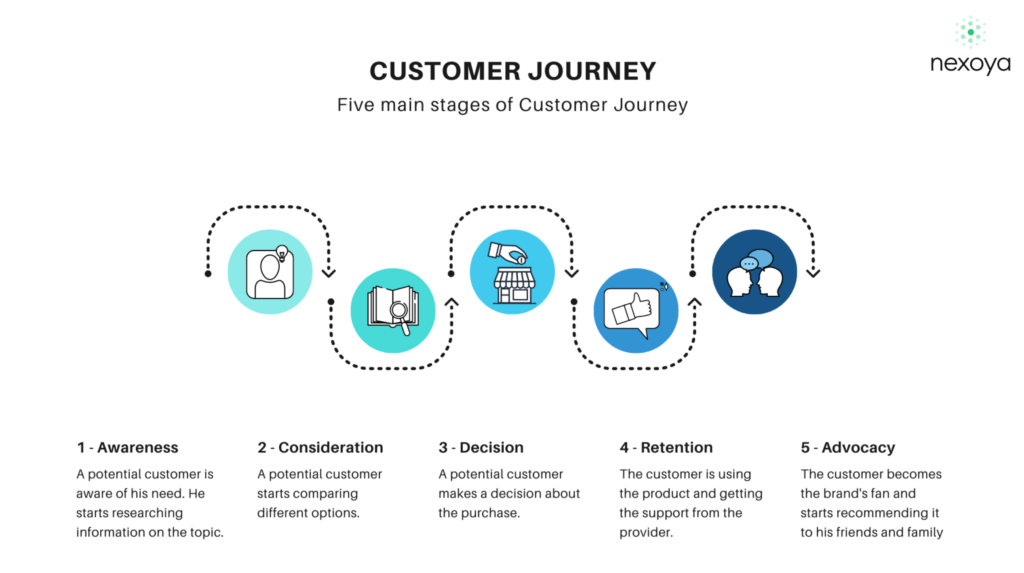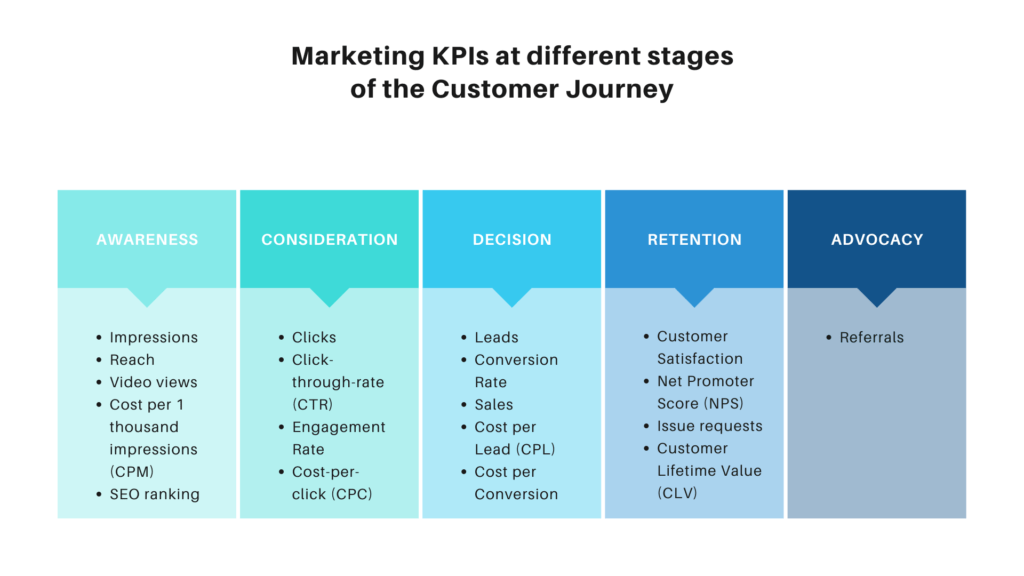Understanding your customers’ behavior at each stage of the Customer Journey is one of the most crucial success factors that many companies forget about. Indeed in today’s fast-moving world in an attempt to automate more and more processes, cut costs and increase ROI, many companies forget about their main judge – the customer who is regularly being bombarded with a number of similar ads and emails.
As a result, companies risk losing any chance of getting through to their potential customers by providing poor customer experience and a low level of personalization. While recent studies show that 86% of users are willing to pay more for great customer experience.
According to Econsultancy, 50% of organizations have either little or no understanding of their customer journey. While getting more insights about your customers’ expectations and experience at each stage of their interaction with your company is a prerequisite of creating a great customer experience.
In this article, we are going to talk about the Customer journey framework and what are the KPIs you need to pay attention to at each stage of your customer journey map.
What exactly is a Customer Journey and why do you need it?
A customer journey is an entire experience your potential customer has with your brand from the time when he first sees your ad until the time he starts recommending your brand to his friends and colleagues. In other words, Customer Journey implies all customer interactions with the company, including all the touchpoints on various channels throughout every stage of the customer lifecycle.

While having a wide range of communication channels companies often forget to align each activity with their customer journey: for example, using different messaging and channels depending on which stage the Customer Journey. As a result, this leads to a disconnected and, therefore, poor customer experience.
It’s important to highlight that as a company you cannot map your Customer’s Journey based on your assumptions without asking your customers first. You simply cannot read their minds.
Therefore, the best way to map your Customer Journey is to talk to your existing customers. It is important to understand how their decision-making process looked like when they decided to buy your product: which channels they used, which messaging they were more attracted to, which factors they were paying attention to at each stage of the Customer Journey. You can answer these questions only by getting to know your customers and their needs and expectations at each stage of their journey.
Why is understanding the Customer Journey crucial in digital marketing?
What exactly are the benefits of the Customer Journey?
- Understanding your customer’s decision-making process
The Customer Journey helps you to get more insights about your customer’s behaviors and their habits at each stage of Customer Journey.
- Possibility to provide great customer experience
By understanding your customers at each stage of their Customer Journey you have a great chance to provide a flawless customer experience.
- Understanding which channels are important at which stage
A customer Journey map also allows you to see which channels are the most crucial at each phase. By using these channels you increase your chance to get qualified leads and conversions.
- Opportunity to create a perfect messaging
By understanding your Customer Journey you can tailor the messaging to the customer’s expectations at each stage, highlighting the factors that are most important for them.
- Opportunity to provide a high level of personalization
By learning more about your Customer Journey you can provide more personalized customer experience. By doing so you increase your chances of conversion.
- Understanding your customers’ pain points
A customer journey map can help you to get valuable insights into common customer pain points and the potential ways to improve those.
- Strategy improvement
Customer Journey helps to monitor the effectiveness of your strategy and define the gaps between your customer’s expectations and reality.
Stages of the Customer Journey
There are different approaches on how to define phases within the Customer Journey. Some of the approaches focus only on the steps before the user converts. While some of them also take into account activities that happen after the decision about the purchase was made.
In general, five main stages of the Customer Journey can be defined:
1. Awareness
The very first stage of the Customer Journey is Awareness. At this stage, your potential customers are aware that they have a specific need or a problem that they need to solve. It can also be the other way around when the customer realizes his need or a problem after he sees the ad that resonates with him. At this point, they start researching the information on the topic and seeking to find the answer to their questions.
Example:
You are not satisfied with your mobile provider and want to change it. You start to google and check out the websites of different providers, different articles on the topic (e.g. ratings of the best providers in your country), consult with friends and colleagues.
2. Consideration
Consideration stage implies the process of analyzing and comparing existing options. In other words, during this stage potential customers are aware of some of the options they can choose from. Therefore, this phase is a perfect opportunity for Content Marketing: newsletter subscriptions, magnets, free templates and webinars.
Example:
After the first research is done, you now can see the main players on the market and their offers. You start comparing different offers from providers and eliminating the ones that are not suitable for you. You subscribe for newsletters to check out the company’s news, interesting blogs and offer updates.
3. Decision
During this stage of the Customer Journey, your potential customer is ready to select from the considered options and make a decision about the purchase. Testimonials, case studies, and reviews play a critical role at this step.
Example:
Imagine that you have already done an analysis and now have three options to choose from. Your main goal is to choose the one that will best fit your needs. You are reading through the reviews and realize that some of them reflect your situation and the problems you had. You have made your final comparison and have selected the option that fits your needs the best and proceed with the contract.
4. Retention
Retention is one of the most important stages in the overall customer journey. Unfortunately, many companies forget about that by only focusing on customer acquisition. However, in fact, only by maintaining your customers, you can ensure your business sustainability. At this stage, you need to make sure that your customer is satisfied and happy with your solution. You notify him about special offers and various incentives that are available.
Example:
You start using the new mobile provider, paying attention to the quality of the connection, you continue receiving nice offers from them, you are exploring your account and can easily access their help center if necessary.
5. Advocacy
This stage of the customer journey is what all the companies are eager to achieve. If the customer achieves this stage it means that he is so happy with your service that he becomes an active advocate for your brand. Customers who achieved these stages are starting to generate one of the most powerful marketing channels – WOM (Word-of-mouth).
Example:
You recommend this provider to your friends, family, and colleagues. You are protecting this brand when somebody is starting to criticize it.
What KPIs do you need to track at each stage of Customer Journey?
It is important to understand that depending on the stage of the customer journey you need to pay attention to different marketing KPIs.

Let us look at the most important marketing KPIs that reflect the effectiveness of your marketing activities at each stage.
Awareness
Since at this stage of the customer Journey the potential customer becomes aware of the problem and start researching more information about the topic, the following Awareness KPIs are important to track:
Marketing KPIs at the Awareness stage:
Consideration
Content marketing plays a significant role in this phase. Therefore, here blog posts, videos, email marketing, and other content come into play. It is crucial to understand that depending on the product complexity the consideration stage may imply multiple engagements.
At this point, KPIs that are reflecting engagement are the most important.
Marketing KPIs at the Consideration stage:
- Clicks
- Click-through-rate (CTR)
- Engagement Rate
- Cost-per-click (CPC)
Decision
KPIs at this stage reflect how effectively you convert your customers. It is important to mention that you should track not only the number of leads and conversion rate but also the average Cost per Lead and Cost per Conversion. It will help you to estimate how much money you spend on one lead/conversion.
Marketing KPIs at the Decision stage:
- Leads
- Conversion Rate
- Sales
- Cost per Lead (CPL)
- Cost per Conversion
Retention
As was mentioned before, one of the most important stages of the Customer Journey. At this phase, companies need to make everything to make their customers happy. Therefore, to measure the effectiveness of your retention strategy the following number of KPIs needs to be monitored.
Marketing KPIs at the Retention stage:
- Customer Loyalty
- Customer Satisfaction
- NetPromoterScore (NPS)
- Feedbacks
- Issue requests
- Customer Lifetime Value (CLV)
Advocacy
To analyze how good you are at the Advocacy stage of the Customer Journey, you need to monitor the number of your referrals.
Marketing KPIs at the Advocacy stage:
- Referrals
We hope that this article was helpful for you and now you can easily track your success at each stage of your Customer Journey.
Download our free ebook and learn the fundamentals of data-drivenness with 17 marketing KPIs!
Learn more about How to organize your paid campaigns with nexoya’s free Excel Template and Seven Mistakes Most People Make When Tracking KPIs!





